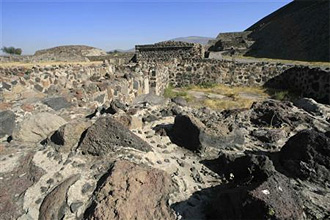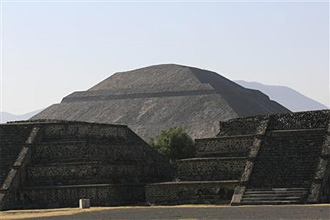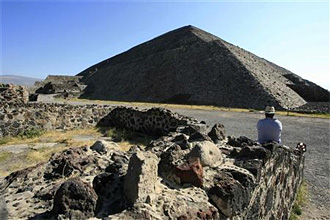
|  |  |  News Around the Republic of Mexico | July 2008 News Around the Republic of Mexico | July 2008  
Researchers Open Secret Cave Under Mexican Pyramid
 Miguel Angel Gutierrez - Reuters Miguel Angel Gutierrez - Reuters
go to original


| | A general view shows the Pyramid of the Sun at the Teotihuacan archaeological site in the outskirts of Mexico City February 2, 2008. | 
| | View shows an area at the base of the Pyramid of the Sun, at the Teotihuacan archaeological site. | 
| | View shows the Pyramid of the Sun at the Teotihuacan archaeological site. | 
| | A man looks at the Pyramid of the Sun at the Teotihuacan archaeological site. (Photos: Reuters/Henry Romero) | | |
Mexico City - Archeologists are opening a cave sealed for more than 30 years deep beneath a Mexican pyramid to look for clues about the mysterious collapse of one of ancient civilization's largest cities.

The soaring Teotihuacan stone pyramids, now a major tourist site about an hour outside Mexico City, were discovered by the ancient Aztecs around 1500 AD, not long before the arrival of Spanish explorers to Mexico.

But little is known about the civilization that built the immense city, with its ceremonial architecture and geometric temples, and then torched and abandoned it around 700 AD.

Archeologists are now revisiting a cave system that is buried 20 feet beneath the towering Pyramid of the Sun and extends into a tunnel stretching for some 295 feet (90 meters) with a height of 8 feet.

They say new excavations begun this month could be the key to unlocking information about the sacred rituals of the people who inhabited the city, later dubbed "The Place Where Men Become Gods" by the Aztecs who believed it was a divine site.

"We think it had a ritual purpose. Offerings were placed at the very end of the tunnel as part of the pyramid's construction process," Mexican archeologist Alejandro Sarabia told Reuters.

"We want to find out why the Teotihuacan people sealed it and when," he said.

Sarabia said the tunnel was first discovered in the early 1970s but it was closed soon afterward, and most of the information about it was lost when the archeologist who found it died.

Teotihuacan is Mexico's oldest major archeological site and during its heyday in 500 AD, the city was home to some 200,000 people, rivaling the size of ancient Rome at that time, according to archeologists.

Today, it is surrounded by encroaching slums spilling over from the outskirts of Mexico City, but swarms of tourists still visit the giant 212-foot (65-meter) sun pyramid each year to celebrate the spring equinox festival marking the sun's return to the northern hemisphere.

(Writing by Mica Rosenberg; Editing by Eric Beech) |

 |
|  |



